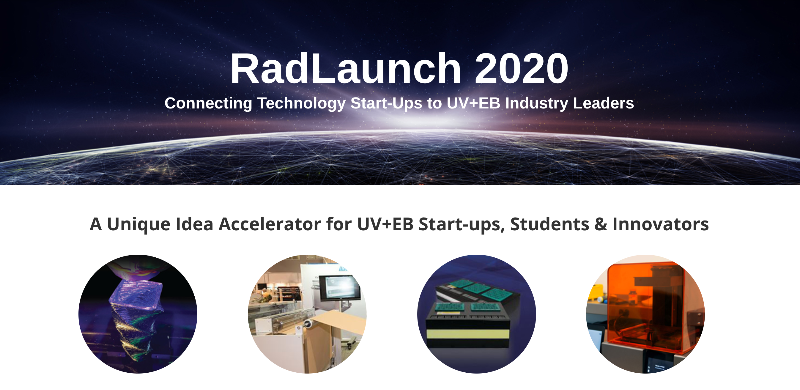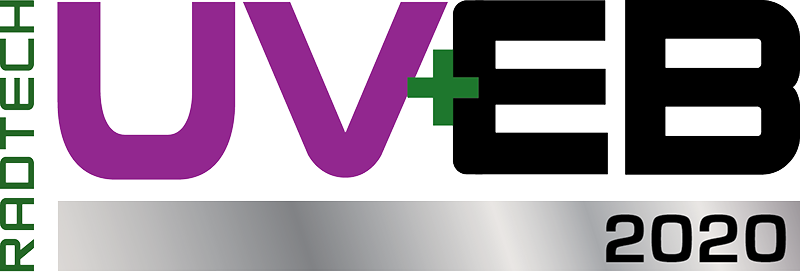The world's largest event dedicated to the educational, technical, and scientific advancement of ultraviolet (UV) and electron beam (EB) technologies.
RadLaunch Announces Start-up Technology Accelerator Class of 2020
FOR IMMEDIATE RELEASE
Contact: Mickey Fortune, 240-643-0517, mickey@radtech.org
Chevy Chase, MD (January 23, 2020) RadLaunch, the unique idea accelerator for ultraviolet (UV) and electron beam (EB) technology start-ups, students, and innovators, has selected five key technology developers for 2020 and three special recognition awards. RadTech, the nonprofit for UV+EB Technology, created RadLaunch in recognition of the growing importance of the technology with the digitization of manufacturing and requirements for safe, clean, rapid processes in the fast emerging circular economy. New innovations in materials, optics, design and data, are propelling UV+EB in additive manufacturing/3D printing, inkjet, food packaging, automotive, medical, public health and electronics applications.
For the first time the competition includes new awards sponsored by the International Ultraviolet Association (IUVA). IUVA is a nonprofit dedicated to UV applications in public health and the environment, with a special focus on water, food and beverage and health care.
The RadLaunch 2020 class will all give presentations at RadTech 2020, www.radtech2020.com and the co-located IUVA Americas 2020 www.iuva.org, March 8-11, 2020 in Orlando, FL.
Meet the RadLaunch Class of 2020

HARP (High-Area Rapid Printing), Azul 3D
This three-year-old startup spun out of Northwestern University and is creating a paradigm shift in the plastics manufacturing sector via a revolutionary 3D-printing technology called HARP (High-Area Rapid Printing). HARP enables record-breaking throughput in the field of stereolithographic printing, regardless of size, by using a mobile liquid interface (a fluorinated oil) to reduce the adhesive forces between the interface and the printed object formed from photo-responsive resins. The bed area is not size-restricted by thermal limitations because the flowing oil enables direct cooling across the entire print area. Importantly, HARP enables the use of both oxygen-sensitive and oxygen-insensitive photo-chemistries at rapid speeds (i.e., does not rely upon oxygen quenching). Resultantly, HARP broadens the scope of UV/EB technology for 3D printing beyond acrylates and methacrylates, being compatible with both photo-cationic and photo-acid initiated reaction mechanisms. Stemming from its industrial-grade photo-resins, HARP offers manufacturers the opportunity for higher throughput, limitless scale, and just-in-time mass production of diverse, customized, and complex products. Most recently, the technology was featured in an article in Science (Oct 2019) and has been featured in many news articles including in C&EN, Popular Mechanics, Economist, and Sciencemag.
Bio-based 1,5-Pentanediol: A New Renewable Monomer for the Radcure Industry, Pyran LLC
The vast majority of chemicals are made from nonrenewable and often expensive petroleum (oil) resources. Pyran co-founders Professor George Huber, Dr. Kevin Barnett, and Dr. Kefeng Huang set out to find a better way, and discovered a new pathway to make a chemical called 1,5-pentanediol (1,5-PDO) from renewable resources, such as corn cobs. Pyran’s technology allows them to make their renewable 1,5-PDO at 30-50% lower costs than similar oil-based chemicals! Pyran’s 1,5-PDO product is a major component in many ultraviolet (UV) cure coatings – which are more efficient and produce much lower amounts of harmful emissions compared to conventional coating technologies – offering consumers environmentally friendly products that won’t break the bank.
Innovative, Low-Cost, Water Purification Method by Leveraging the Synergetic Effect of UV and IR Radiation from the Sun, Sujay M. Swain, Montgomery Blair High School
Over one billion people in the world do not have access to clean drinking water. By using waste products, a low-cost water purification method to holistically purify water from physical, chemical and biological impurities was developed. Sugarcane bagasse was used to remove physical impurities and activated carbon synthesized from sugarcane juice was used to remove chemical impurities. Finally, by leveraging the synergetic effect of UVA and heat (from Sun), biological impurities were successfully removed. Resulting purified water met all the standards set by FDA. With the insight gained from this research, a portable water purification system using UVA LEDs is under development.
Solvent-free radical photopolymerization that continues its extensive post-conversion in the dark, Team from University of Colorado
A new photoinitiating system with unprecedented photo-efficiency and extensive post-conversion in the dark has been developed at the University of Colorado by the team of Kangmin Kim, Jasmine Sinha, Charles Musgrave, and Jeff Stansbury. This innovation allows reduced light exposure times while guaranteeing complete polymerization, even in situations involving compromised light access due to nonuniform light sources, irregular surfaces, or thicker samples that might otherwise preclude a photocuring process. This discovery will further elevate the green technology to a new standard and increase the scope of photocuring technologies into new application areas.
Real-time feedback controlled monomer conversion: a new paradigm for UV curing process control, Eindhoven University of Technology’s High Tech Systems Center and TNO (Eindhoven, The Netherlands)
To prepare UV curing technology for the imminent fourth industrial revolution, PhD researcher Thomas Hafkamp from Eindhoven University of Technology proposes a new paradigm for UV curing process control. The proposal consists of acquiring in-situ measurement data of monomer conversion from a spectrometer and feeding this data into a real-time feedback controller. The feedback controller computes a corrective action for the UV light source if the monomer conversion momentarily deviates from the intended value. This innovation makes the UV curing process more robust to disturbances and may prove to be an indispensable solution for quality control.
All-in-one (AIO) Solar-LED Purification Bottle for Every Home Use, Dana Pousty, Prof. Hadas Mamane, Water Research Center, School of Mechanical Engineering, Tel-Aviv University
The utilization of non-chemical disinfection systems for water treatment such as ultraviolet (UV) is increasing rapidly. Currently, the dominating systems are mercury-based low-pressure (LP) and medium-pressure (MP) lamps. These lamps are not optimal for point of use (POU) systems that are characterized by (a) intermittent or non-continuous water supplies, (b) need for off-the-grid applications, (c) release heat to the water and result in inorganic fouling, and (e) the high output power (MP lamps). UV light-emitting diodes (UV-LEDs) overcome these drawbacks with adjustable wavelengths according to the need, long life-time, constant output and operate at ambient temperatures. Moreover, they hold compact and flexible structures that enable adapted design. The water-tech lab at Tel-Aviv University is developing a solar-based UV-LED-based optimized point-of-use water treatment solutions by combining various wavelengths. This will open a new field of portable point-of-use home applications.
Next-Generation Energy Storage with UV Curing of Novel Polymer Electrolyte Materials, The Hosein Research Group, Syracuse University
The ever-increasing demand for Li-ion battery storage solutions will soon present an imminent crisis with the availability of mineral lithium to support the clean energy economy. This has led researchers to consider batteries from earth-abundant minerals, such as sodium, calcium, magnesium, and aluminum. The challenge with such next-generation batteries is developing suitable electrolytes. To this end, polymer electrolytes are an attractive solution owing to their high conductivity, as well as mechanical and thermal conductivity. The Hosein Research group at Syracuse University has employed UV-curing to effectively produce both acrylic and epoxy based polymer electrolytes. UV-curing enables the rapid, uniform, and scalable processing of polymer electrolytes, which show suitable properties and most recently have been shown to effectively operate in prototype next-generation batteries.
Novel UV-initiated Dual-curing thermoset materials suitable for 3D printing, Hamidreza Asemani, Professor Vijay Mannari; Coatings Research Institute, Eastern Michigan University, Ypsilanti, MI
While 3D-printing is fast emerging as a fascinating technology of the future, one major challenge faced by 3D-printed products is their sub-optimum performance due to poor inter-layer adhesion between multiple stacking up layers in their assembly. A team of Prof. Vijay Mannari and Ph.D. candidate Hamid Asemani at Eastern Michigan University has developed a very meticulous solution to this challenge. They have designed a 3D printing material that cures by two independent cure mechanisms – one providing rapid green strength development for faster processing while the second one allows for chemical bonding between the layers – thus significantly enhancing final product performance. The proposed system is enabled by UV-curing technology making it efficient and environmentally responsible.
Special IUVA student awards:

